Madrid/La Latina-Austrias
La Latina and Austrias are neighbourhoods in central Madrid. They can be labelled as the old town of the Spanish capital.
Understand
El Madrid de los Austrias or barrio de los Austrias is named after the "House of Austria", another name for the Habsburg dynasty who had their ancestral seat in Austria, but also ruled the Spanish Empire for nearly two centuries, when it was at the height of its power (16th and 17th centuries). The first Spanish King from the House of Habsburg Carlos I (Charles V of the Holy Roman Empire) did not reside in Madrid, but Felipe II, his son, moved the residence there and the Spanish Habsburgs built a lot of stuff in Madrid up until the death of Carlos II, a sickly child whose inability to produce an heir may or may not have been due to severe royal inbreeding. This district is the traditional royal and political centre of power, encompassing the Royal Palace, Plaza Mayor (the main square of old Madrid), the old town hall, the Foreign Ministry and other government offices. Several of Madrid's most famous sights are concentrated here as well as the main flow of tourists.
Get in
Metro stations in this part of the city are , and . Station (also Cercanías/suburban rail C1, C7, C10) is near the northwestern corner of Austrias, (and Cercanías C5) in the southeastern corner of La Latina. From the central it is just a 350-metre walk to Plaza Mayor.
See
Landmarks and architecture
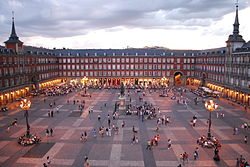
Plaza MayorPerhaps the best known plaza in Madrid, this impressive square is now one of the main stops on any tourist visit. This enclosed square was built outside the city walls, and has played host to bullfights, markets, symphonies, tournaments and executions. Today it is ringed with tourist shops, cafes and restaurants. The statue of Philip III sits in the middle across from the Casa de la Panadería, a beautifully painted building with two towers on the north side of the square (not to be confused with the other building with two towers on the opposite side) which once served as the headquarters of the bakers' guild and now houses a tourist information office. Access to the square is via one of the many arcades which connect to the surrounding pedestrian streets.
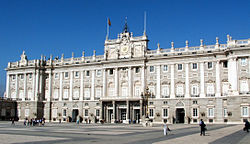
-
phone: +34 91 4548800address: Calle BailenThe Palacio Real is an enormous palace, one of the biggest in Europe, with scorching plains of concrete around it. Though it is the official residence of the King of Spain, the royal family does not actually reside here and it is generally used only for state ceremonies. The Royal Palace is considered to be one of the most emblematic and beautiful buildings in Madrid, not only for its location on a bluff overlooking the river valley but also for its architecture and the artistic treasures to be found in its rooms. A simple one-way tour of the palace (both self-guided and guided are available) takes you up the grand stairway and through the lavishly decorated state rooms with their elegant tapestries, frescoes, porcelain, carvings and added decor like china, silverware, medals, etc. From the courtyard you can access the Farmacia (Pharmacy), which contains hundreds of bottles of early medicines and a reconstructed laboratory, and the Real Armorial (Royal Armory), a two-story collection of medieval weapons and armor. Explanations in the armory are in Spanish only, so do not expect to understand much unless your know the Spanish names for all that medieval weaponry.
The lines to get in are very long, especially on weekday evenings when the place is free – try to go early. Photography inside the palace is not allowed, but is permitted in the foyer and courtyard. Free storage lockers are available behind the ticket office.
The Palace was built on the site of an Alcazar (a Muslim fortress) which had been used as a palace but burned down. It was one of the first major buildings by the new Bourbon dynasty and shows a departure from the earlier styles and tastes of the Habsburgs in evidence in other royal buildings in the area.
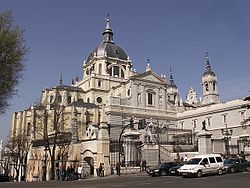
Catedral de la AlmudenaThis massive cathedral faces the Palacio Real. Finished near the end of 20th century in the Neo-Gothic style, it is where the Princes of Asturias Felipe (current King Felipe VI) and Letizia were married in 2004. Especially noteworthy are the 5,000-pipe organ, a large painted 15th-century Gothic altarpiece, and the empty 12th-century coffin of Madrid's patron saint, Isidro. Like many cathedrals before it, construction took a while, being started in the 19th century while it was only inaugurated in 1992. The cathedral thus reflects a mixture of styles which sometimes harmonize and sometimes clash. One of the reasons for the late start of construction of a cathedral in the capital of one of the world's most catholic states was the power of the archbishops of Toledo who did not want to give up their ecclesiastical power to the upstart Madrid. Similarly the monarchy had moved its residence from Toledo to Madrid in part to escape the influence of the church and installing a bishop in Madrid (a requirement for a cathedral) seemed somewhat counter productive. The cathedral is also the site of many burials of important figures, including the daughter of Franco.

Mercado de la CebadaOnce a glass and iron market of the late 19th century, it is now a vaulted concrete building which still serves as a neighborhood market. Where it used to stand an annexed public swimming pool and sports facilities, it lies now an empty field, used and managed by a neighbor association.
Plaza de la VillaThe main square during the Middle Ages, as Calle Mayor (High Street) was the main street as well. It houses the former City Hall, the former Academy of Fine Arts, and the Archbishopric.
Museums
-
phone: +34 913 667 415address: Plaza San Andres, 2This is a museum of two parts. One part is dedicated to Saint Isidore the Laborer, while the other part is dedicated to the paleontology and archaeology of the region of Madrid from prehistory to 1561 (when Philip II made Madrid the seat of the court). Most of the exhibits are explained in both Spanish and English.
Do
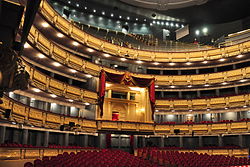
Flamenco shows
-
phone: +34 913 658 446address: C/ Morería, 17One of the most famous flamenco tablaos in the world. It′s right in the heart of the city, and you can enjoy a full-fledged Spanish meal while you watch performances by renowned international flamenco music and dance artists.
-
phone: +34 915 595 135address: C/ Torija, 7-28013A great show lasting about 90 minutes. Unbelievable amount of energy and passion put in by the performers. There is an option to have dinner as well but that is a separate package and costs more.
Opera
-
phone: +34 915 160 660 (box office), +34 902 244 848 (telephone sales)address: Plaza de Isabel II, s/nThe main opera theatre in Madrid. Tickets can be purchased online here.
Learn
-
phone: +34 913 604 133address: C/ Duque de Liria, 6A great school where you can take 4-6 hours of courses a day. All courses including beginner courses are taught entirely in Spanish.
Buy
El RastroMadrid's largest flea market, featuring rows upon rows of private vendors selling a variety of homemade bads, and a plethora of live entertainment. Mnay - but by no means all - stores along the side streets also open Sunday morning and some of the stores offer truly bizarre stuff, mostly in the realm of "antiques", used or second hand stuff of various kinds. The Rastro is notorious for having an abundance of pickpockets, so watch your handbag closely and do not bring along valuables.
Mercado de San MiguelNear Plaza Mayor is this indoor market, identifiable by its ornate iron posts. Built in 1913, it's full of a wide range of high quality food. Even if you're not buying anything, it's worth entering for the sights and smells of dried ham, fine wine, freshly baked goods and other treats from the vendors inside. Sets the ambience of a traditional market, with the advantages of the new times. It has an iron and glass structure from the 20th century. This is also a good place for tapas and drinks.
Eat

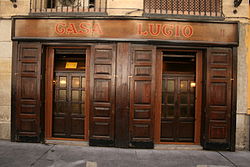
Budget
Mid-range
-
phone: +34 915 476 930address: C/ Bola, 5A family-run restaurant operating since 1870 and serving traditional Madrileño cuisine. Reservations can be made online.
-
phone: +34 913 656 546address: Pasadizo de San Ginés, 5Specializing in chocolate con churros, this Madrid fixture is the perfect place to top off a night on the town. Also offers the usual assortment of coffees and teas.
-
phone: +34 913 655 241address: C/ Ruda, 5Serves typical Madrid cuisine.
Splurge
-
phone: +34 913 653 253address: C/ Cava Baja 35Pricey but worth it. The Spanish Royal family sometimes entertain guests here and you may run into a few sports figures and movie stars. You should definitely book ahead on the weekends, and reservations are recommended even for the weekdays. Known for their cocido, their roasts and their huevos rotos.
-
phone: +34 913 664 217address: C/ Cuchilleros, 17Opened in 1725, Botín is listed in the Guinness Book of Records as the oldest operating restaurant in the world. Once a favourite of Ernest Hemingway, the menu still delights with specialities including cochinillo (roast suckling pig) and cordero (roast lamb).
Drink
Calle Cava BajaThis narrow street in La Latina is by far the most famous and popular place for tapas. It is also the place to go for the traditional Sunday-noon "Vermouth Hour" (after mass or shopping on El Rastro flea market).
-
phone: +34 681 007 700address: Plaza de San Miguel, s/nSherry-tasting available in 8 languages. Commentary by knowledgeable oenologists explaining the details of the history, elaboration methods and tasting notes for each of the wines, while inviting guests to combine them with tapas served at different market stalls.
-
address: Plaza Oriente 2Overlooks the Plaza Oriente and faces Palacio Real. Outdoor tables in summer, cozy indoor rooms in the cold months. Basement banquet room with a glass floor over ancient remains. Excellent food.
-
La Corolla
address: Visitag Manzana 10Specializes in delicious ‘tostas’ (small pieces of toast with different toppings) and avocado (aguacate), along with cañas (small beers). -
Joy
address: Calle Arenal 11Well known across Europe. Attracts at multi-national crowd. Popular with tourists as well as locals. It plays a mix of popular dance music. Every Thursday there is a Students Party.
Sleep
-
phone: +34 91 559 2472address: Calle Arenal 26 Piso 4Very central location. Breakfast is offered. There is a lounge area, a kitchen in which you are able to cook your own food, and a bar. The beds are clean, comfortable, and the staff are friendly.
-
phone: +34 91 541 28 05address: Calle Campomanes 74-star hotel in an exquisite historic building of the XIX century in the historic center of Madrid that has been transformed into a state-of-the-art boutique hotel. A classic atmosphere blended with modern decorative touches - a balance of unpretentious formality and well tempered cordiality.
